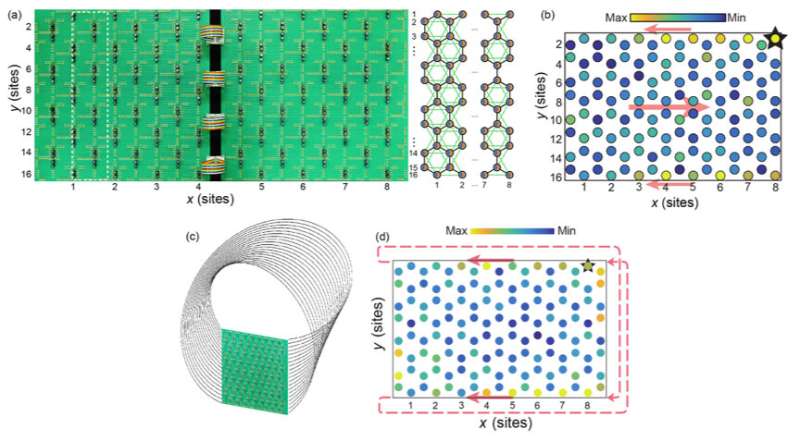Observation of antichiral edge states in a circuit lattice

A modified Haldane lattice exhibits the intriguing phenomenon of antichiral edge states that propagate in the same direction on opposite edges and co-exist with bulk states. Using an electric circuit, researchers have successfully demonstrated antichiral edge states. By measuring voltage distributions in the circuit, the key features of the antichiral edge states have been verified experimentally for the first time, including their group velocities and ability to propagate consistently in a Möbius strip configuration.
Originally formulated in the context of condensed matter physics, the Haldane model is an influential model of a two-dimensional topological insulator. It has also been realized in classical-wave metamaterial analogs of topological insulator, such as photonic crystals, acoustic crystals, and electric LC circuits.
Recently, theorists have shown that a modification to the Haldane model exhibits the novel phenomenon of antichiral edge sates, according to E. Colomés and M. Franz, scholars at Department of Physics and Astronomy and Quantum Matter Institute, University of British Columbia. Unlike the chiral edge states associated with the standard Haldane model, antichiral edge states possess the same propagation direction on opposite edges of a sample; the current carried by the edge states is compensated by counter-propagating bulk states. However, the modified Haldane model has thus far never been realized in any experimental setting. In condensed matter, it is extremely challenging to achieve since it requires an unusual configuration of magnetic vector potentials within each crystalline unit cell.
An article coauthored by Profs. ZhiHong Hang and Yidong Chong, from Soochow University and Nanyang Technological University, respectively, provided the first experimental realization of a modified Haldane model, consisting of electrical circuit lattices. This study entitled "Observation of antichiral edge states in a circuit lattice," was published in Science China Physics, Mechanics & Astronomy. These researchers provide direct experimental evidence that the circuit lattice exhibits edge states, and that their propagation is antichiral. Their experimental results are in good agreement not only with theory, but also with numerical circuit simulations. "It opens the door to further experimental explorations of the properties of antichiral edge states in a real physical system," the researchers stated.
"This work demonstrates the flexibility of electrical circuit lattices as an experimental platform for realizing lattice models with effective magnetic vector potentials," they explained. Previous researchers had shown how to use circuits to implement a very well-studied topological phase (the Chern insulator, i.e. the simplest two-dimensional topological insulator), whereas in their study they implemented a very novel and nontrivial model (the modified Haldane model).
This experiments also point to the intriguing possibility of using circuit lattices to explore models with Möbius strip geometries and other exotic configurations, which may be a rich avenue of future research.
More information: YuTing Yang et al. Observation of antichiral edge states in a circuit lattice, Science China Physics, Mechanics & Astronomy (2021). DOI: 10.1007/s11433-021-1675-0
Provided by Science China Press




















